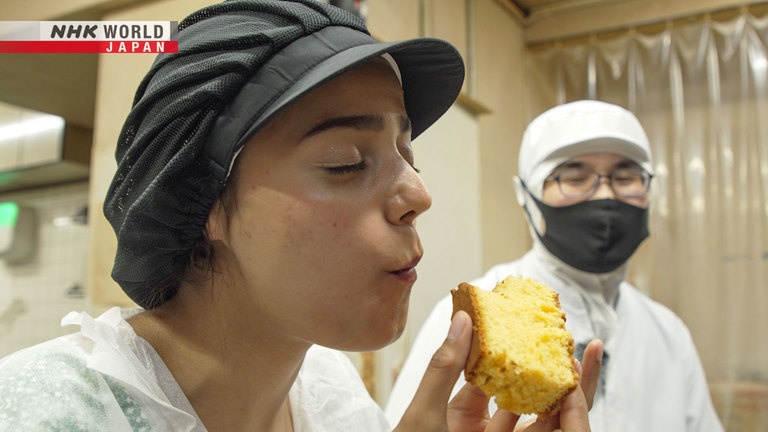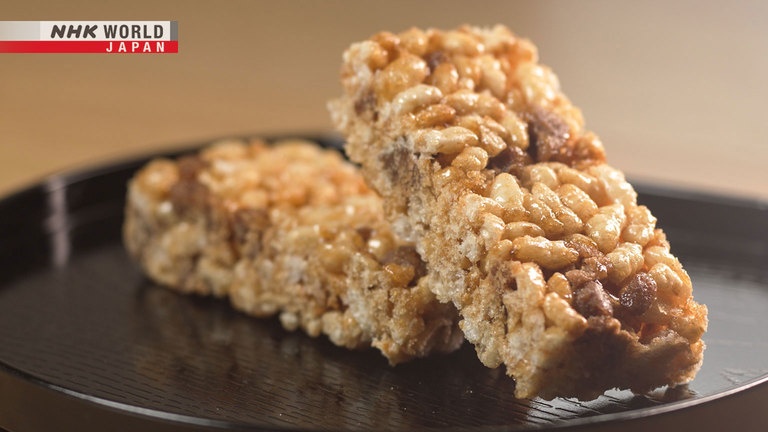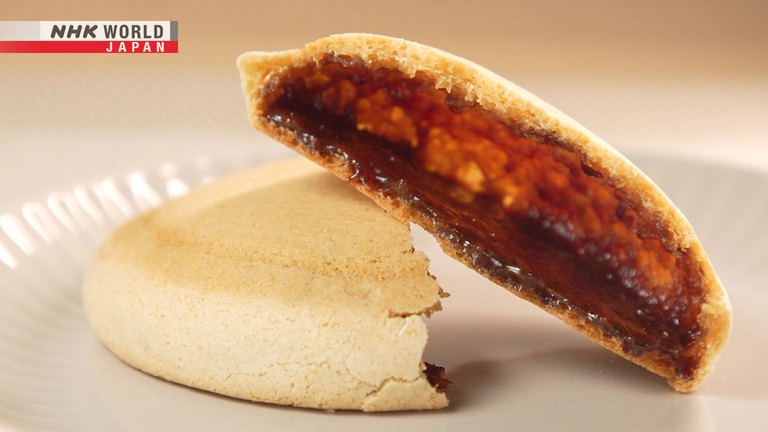On The Sugar Road from Nagasaki to Saga
The Nagasaki Kaido Road connects the port of Nagasaki Prefecture, the only point open to overseas trade during Japan's period of isolation, with Kokura in Fukuoka Prefecture. It is known as the Sugar Road for the many confections inspired by mainland Asia and Europe that spread along it. Aliza Ahmed Khan, who is from Pakistan, explores this rich world.
Nagasaki Castella

The original cake recipe of flour, egg and sugar, was imported from Portugal around the mid-16th century and adapted to the Japanese palate.
Isahaya Okoshi

Rice grown on the vast farmland of Isahaya is a major ingredient of the sweet, which has its origins in China. Made by coating dried rice with heated starch syrup and brown sugar.
Ikkoko

This confection is filled with brown sugar paste, which evaporates during the baking leaving the inside hollow but not losing the rich flavor.
Access

It takes about two hours from Tokyo's Haneda Airport to Nagasaki Airport. From there, take the Nishi Kyushu Shinkansen to Isahaya and Ureshino. A park near Nagasaki Airport has a stunning beach with recycled glass mixed in its sand.
Transcript
"Journeys in Japan"
Hello.
My name is Aliza Ahmed Khan,
and right now, I am located in Nagasaki Prefecture.
This beach is a little bit unusual.
It has colorful grains mixed with sand.
My journey this time will focus on one thing
that is as smooth and silky as this sand
that has changed the Japanese food culture.
And what could that be?
Sugar,
embraced in Japan from the 16th century
to confect irresistible sweets.
Aliza Ahmed Khan is from Pakistan.
She follows the sugar culture that dusts the Nagasaki Kaido road.
That looks hot.
Wow. It's so soft.
Traditional skills passed down for centuries.
It's so severe.
There's nothing inside.
t's so much fun!
On "Journeys in Japan," we tour Nagasaki's sweet legacy.
On The Sugar Road from Nagasaki to Saga
Nagasaki Prefecture is some 950 kilometers southwest of Tokyo in Kyushu.
The Nagasaki Kaido extends about 220 kilometers to Kokura,
a port town across from Japan's main island.
(Nagasaki City)
Nagasaki flourished as a maritime hub for international trade from the middle ages.
A distinctive culture developed in the city
with mainland Asian and European influences.
(Dejima)
Dejima was the only official trading base in Japan
when the country was sealed off from the world for about 200 years,
starting in the early 17th century.
And it was from this port that sugar took hold in Japan.
This is Storehouse Number 3. It was mainly for sugar.
It's so huge.
Wow, look at that.
These hemp sacks contained sugar.
Each one weighed 60 kilograms.
That's a lot of sugar.
What are these?
These are sweets that developed on the Nagasaki Kaido with the Dejima sugar imports.
- They are all made with sugar.
- Yes.
Oh, I'm finally here.
I can taste it. I can feel it. It's so sweet.
Let's just go inside.
You have many types of sweets.
- Is Castella the name of a cake?
- Yes.
This is castella.
Thank you so much.
Castella was introduced to Nagasaki around the 16th century
by Portuguese traders and missionaries,
who used the cakes to attract followers.
It's a deceptively simple affair of wheat flour, eggs and sugar.
This marriage of the sweetness of the sugar and the richness of egg
created a completely new taste sensation for the Japanese palate.
Wow.
That's a lot.
- What was that?
- Sugar.
It seems like the ingredients are very simple,
but the procedure is a little too hard for me to understand,
so I want to see how it goes.
"Mizuame" starch syrup is the surprise ingredient.
The syrup, made with rice and barley, gives the dough its satisfying moist texture.
It's one of the ways the original recipe from Portugal was enhanced.
This is a coarse sugar called "zarame."
You add it directly...
Yes. We stir it in.
Nagasaki castella is famous for its zarame.
When the mix is transferred to the mold...
...the zarame, which is heavier than the other ingredients, sinks to the bottom.
- That means the bottom gets...
- lined with sugar.
The castella is baked in special pans for about two hours.
We begin the tricky process of "awakiri," or getting rid of bubbles.
Can you see the bubbles?
We spray water and remove them with the spatula to even out the surface.
Do you see the bubbles disappearing?
It looks very hot.
The aroma is so sweet
and gives you a very, very pleasant feeling.
My hands are shivering because it's so soft.
It's so beautiful. I don't want to cut it.
But I want to eat it.
Look at this!
It's so soft and warm right now.
It's sweet but not very sweet.
And the softness, it's way too soft and moist.
And the sweetness is just so balanced.
I like the difference in texture between the top and the bottom.
By the early 18th century,
ships from Europe and China were bringing in over 2,000 tons of sugar
annually to Japan via Nagasaki's port.
The "white gold" brought huge prosperity to the city.
(Nagasaki Museum of History and Culture)
Wow, what a beautiful old painting it is.
This folding screen painting depicts Nagasaki in the late 17th century.
The coveted sugar unloaded at Dejima
circulated around Nagasaki via various routes.
People wanted sweet sugar. But they couldn't produce much in Japan.
So, brokers bought sugar from trade ships from the Netherlands and China.
Sugar was distributed across the country from Nagasaki.
This is outside of Dejima in downtown Nagasaki.
You can see many people on the main street.
This is the Nagasaki Kunchi. It is still a favorite festival for people in Nagasaki.
Dutch traders donated sugar in return for being allowed to view the festival.
Records show that they gave 4 to 6 tons of sugar.
Sugar unloaded in Nagasaki brought enormous benefits to the town.
Records show that sugar was treasured by the people here. It was as valuable as money.
- What do you think happened here?
- They dropped something?
They dropped and broke a pot of sugar.
They might have dropped it on purpose.
Why?
When the laborers picked up something that spilled from their loads, they were allowed to keep it.
So, they likely dropped it on purpose to obtain the sugar.
Dejima courtesans were given gifts of sugar for their services.
Oh, I found it.
It says "Nagasaki Kaido starts from here."
Actually, we don't know the exact starting point,
but it is said that it was somewhere around this area.
What other sweets developed along the Nagasaki Kaido?
Aliza heads for Isahaya, about 20 kilometers away.
(Himi mountain pass)
I heard that Nagasaki Highway has a number of slopes like the one I'm climbing right now.
It's so severe.
I can hardly breathe.
People in the old days used to walk about 220 kilometers in about seven days.
It's unbelievable.
Vast fields fan out in Isahaya, which sits on reclaimed land.
It's a leading region for wheat and rice cultivation.
(Isahaya City)
Look.
As far as my eyes can see, I see beautiful fields of wheat.
This is so vast and breathtaking.
It is said that this vast land was originally the sea.
It was then reclaimed and turned into farmland.
The wheat will soon be harvested and turned into "oishi" rice.
Isahaya "Okoshi" is made with the area's abundant rice
and the sugar that made its way here along the Nagasaki Kaido.
This confectionery maker, which has been in business for 230 years,
produces Okoshi in the time-honored fashion.
This is dried rice, one of the ingredients.
Hoshii is made by brining and drying rice before roasting.
It's not like rice. It's very...
crispy.
But it has a very plain taste.
We also use starch syrup,
and brown sugar in lump form,
as well as powder.
Okoshi is made by mixing them all.
- Are you starting?
- Yes. First add the starch syrup...
Ah, the dried rice and sugar.
Black sugar.
Mix them for about 90 seconds.
What is that?
Wow, their techniques are so cool.
The Okoshi surface, with its piping brown sugar and starch syrup,
is about 80 degrees Celsius.
- Isn't it hot?
- Yes, it is.
Yet, they still use their bare hands?
They're used to it.
You're touching something really hot.
Doesn't it burn your hands?
Not at all.
- May I touch your hands?
- Sure.
It's hard.
- Can you feel sensation in your hands?
- Of course.
- Would you like to try our fresh Okoshi?
- I'd love to.
It's hot.
It is not extremely sweet.
It has a very delicate sweetness.
I love the textures, the crispness, the crunchiness.
Aliza is continuing on to Shiotatsu town via Ureshino in Saga.
(Ureshino City, Saga Pref.)
Ureshino is an old hot spring resort.
What's that?
It's a footbath.
I hope I can try.
Oh, it's so warm and so nice.
It's so relaxing.
Oh, let's get inside. Oh!
It's a little hot for me.
It's hot.
Downstream from Ureshino is Shiotatsu,
a place with especially deep ties to sugar.
Wow,
what beautiful Japanese traditional buildings they are.
I did not know something like this old still existed.
It's so stunning.
Wow.
What a beautiful Japanese building.
It was restored recently.
It used to be a rice shop and residence.
The Shiota district along the Nagasaki Kaido prospered as a post town.
The sugar that arrived from abroad was transported to Shiota.
There was a sugar market here.
There are many confectioners that made sweets with the sugar.
- You mean sweet shops?
- Yes. There used to be eight of them.
- Eight?
- Amazing, isn't it?
This confectionery maker had been in business until 10 years ago.
What's that? Baba-san.
There are so many. What are they?
Molds for sweets.
Carved in many shapes.
Rice flour, starch and sugar are mixed, softened and then pressed into the molds.
"Kosako" is a dry, pressed sweet that is prepared with rice flour and sugar.
It's typically served with tea or as an offering to family altars.
These are the home owners.
Hello.
My father was a confectioner.
Let me show you his tools.
You dissolve food coloring in water for blow painting.
Not brush painting.
Why?
- If you use a brush the sugar might melt.
- I see.
That's what I am guessing. I never asked my father.
- Would you like to give it a try?
- May I?
It makes me nervous.
Okay.
The coloring comes out of the tip. Point it toward the sweet.
My heart is beating so fast, I cannot tell you.
Okay, but let me try.
I did it!
You're good at it.
It's so much fun!
I can't believe it's your first time.
- I've never done it myself.
- Really?
It's so much fun.
Look at this.
You must be tired after walking along the Nagasaki Kaido.
A little bit.
- It makes you crave something sweet.
- True.
This is for you.
Thank you.
What is it? Let me open it.
I can't wait to taste this.
It's hard.
It's very tough.
- May I?
- Sure, go ahead.
There's nothing inside!
There's nothing inside, but it's very sweet.
What's this black stuff?
Caramel?
It's raw sugar.
Oh, brown sugar.
When the flour dough which is filled with a paste of brown sugar is baked,
the paste evaporates and hollows out.
Originating from China, it's called "Ikkoko,"
literally meaning "a fragrant bite."
It's coated everywhere, so you can have a bite from any side
and it will taste the same flavor.
Rather than eating it bit by bit...
Yes, you'd better take big bites.
We get to enjoy Ikkoko today, thanks to people
past and present who have preserved it.
This is my last bite and I'm going to enjoy it to my fullest.
Here we go.
The history of sugar is said to have begun from India,
and then it was introduced to Muslim and Christian countries.
It eventually came to Japan, a country of Shintoism and Buddhism.
I encountered three kinds of sweets on my trip along the Nagasaki Highway,
and I enjoyed them all.
Although they use a lot of sugar, I was surprised by their gentle sweetness.
It was a very valuable experience
to see the attention to detail and skills of the confectioners.
I'm looking forward to see what kind of sweets
I'll encounter in the future.
Although I'm sad to say goodbye,
I hope we will meet again.
Until next time, "Allah Hafiz!"
It takes about two hours
from Tokyo's Haneda Airport to Nagasaki.
From there, take the Shinkansen
to Ureshino and Isahaya.
Don't miss the stunning beach near Nagasaki Airport
with its recycled glass mixed in its sand.